The images used in this review come courtesy of Peter Trippi, one of the curators of the show, and include some by the author himself. Please ask for permission if you wish to reuse them. [Click on all the images to enlarge them.]— JB
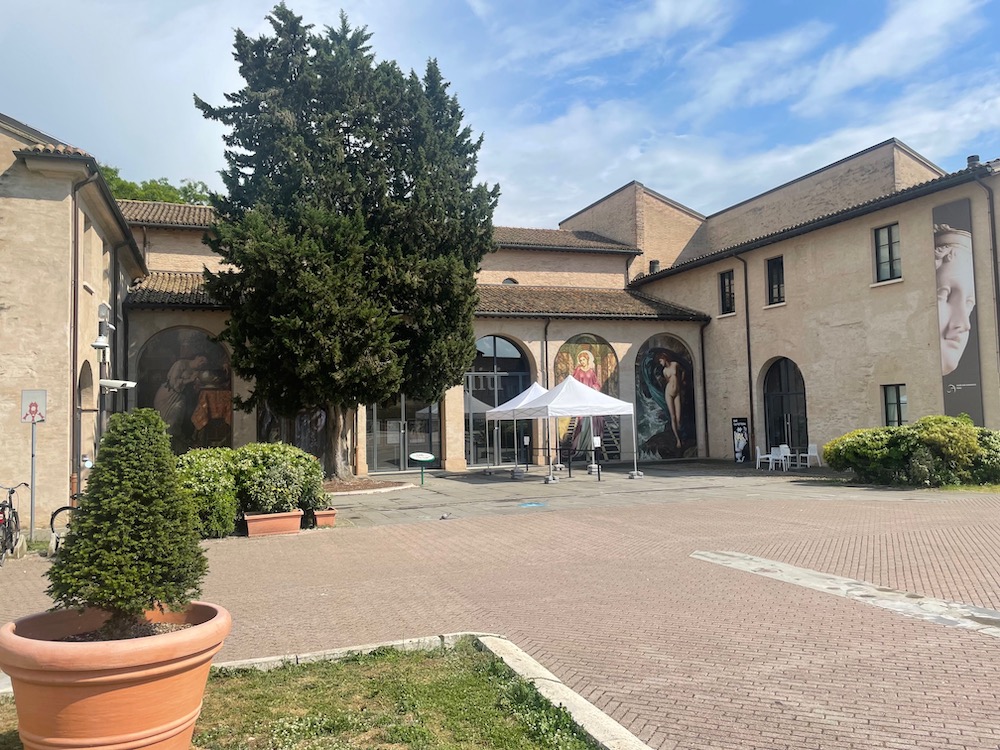
Entrance to San Dominica Museum, Forli.
This exhibition now being held in Forli, Italy, at the San Domenico Museum from February 24 - June 30, 2024 is the first major exhibition in Italy to examine the profound influence of Italian art of the fourteenth to sixteenth centuries, not just on the British Pre-Raphaelite Movement, but on English artists and craftsmen in general, with this influence extending up into the 1920s. The exhibition was co-curated by Elizabeth Prettejohn, Peter Trippi, Cristina Acidini, and Francesco Parisi, and features more than 350 fine and decorative artworks including paintings, watercolours, prints and drawings, illustrated books, sculpture, stained glass, tapestries, wallpaper, ceramics, furniture, metalwork and jewelry. The decorative arts have been expertly chosen and well integrated into the show. This is obviously not the first exhibition to examine the impact of the art of Renaissance Italy on British nineteenth-century painters. The Pre-Raphaelites and Italy, held at the Ashmolean Museum in Oxford in 2010, and Truth & Beauty: The Pre-Raphaelites and the Old Masters, held at the Legion of Honor, San Francisco, in 2018 did much the same, albeit with slightly different focuses. This is first show in Italy, however, to extensively examine this relationship. Being held in Italy it is able to do what exhibitions in England or America would not have been able to represent even close to the same degree – to integrate Old Master paintings more fully into the exhibition in conjunction with the Victorian works.
The Influence of Italian Art
This influence is obvious as soon as one first enters the exhibition into a large room that had once been the Church of St. James in a Dominican convent constructed in the thirteenth century. Immediately off to the left in this room can be seen Frederic Leighton's oil sketch for his first masterpiece, Cimabue's Celebrated Madonna Carried in Procession through the Streets of Florence, hung in juxtaposition with Cimabue's Madonna Enthroned with Child. While Renaissance Old Masters are incorporated throughout the exhibition the early works of the trecento and quattrocento are particularly concentrated in this initial large room, including examples of such important early Italian artists as Taddeo Di Bartolo, Cosimo Rosselli, Fra Angelico, Benozzo Gozzoli, Andrea della Robbia, Filippo Lippi, Luca Signorelli, and Sandro Botticelli. The highlight for me was a Botticelli's Pallas and the Centaur. By the nineteenth- century Botticelli had largely fallen into obscurity until "rediscovered" by English artists and scholars like John Ruskin.


(Church) Left: Frederic Leighton's Cimabue's Celebrated Madonna Carried in Procession through the Streets of Florence, hung in juxtaposition to Cimabue's Madonna Enthroned with Child. Right: Botticelli's Pallas and the Centaur.
F. W. Pomeroy's full-length sculpture of Perseus with the Head of Medusa of 1898, placed in the centre of this room, looks as much at home as would have Benvenuto Cellini's version of 1554 that obviously inspired it. This space includes as well four large murals by Frederick Cayley Robinson, a late follower of Pre-Raphaelitism. Robinson had lived in Italy from 1898 to 1902 and he was influenced, not just by Edward Burne-Jones (see Robinson's Orphan Girls Entering the Refectory of a Hospital), but also by the so-called "Italian Primitives," especially Piero della Francesca. At the end of this large room are four of the Holy Grail Tapestries designed by Burne-Jones and made by Morris & Co. that look absolutely splendid against the background of the rich dark blue walls.

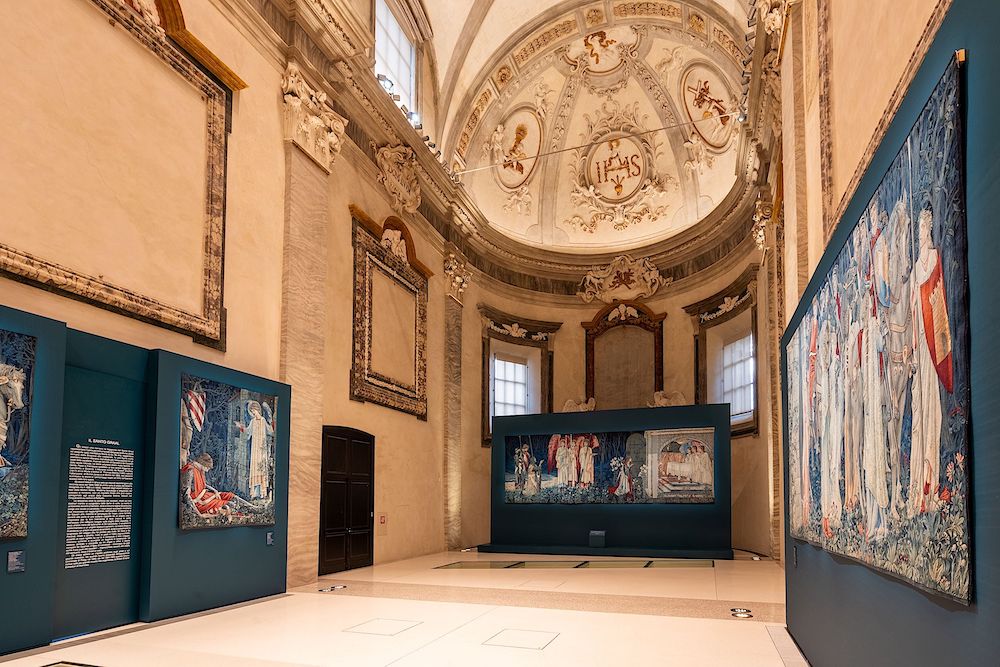
Left: Pomeroy's full-length sculpture of Perseus with the Head of Medusa. Right: (Church) Burne-Jones's Holy Grail tapestries. Right:
First, second, and third generation Pre-Raphaelite painters are represented in the exhibition. In 1848, the year the Pre-Raphaelite Brotherhood was founded, its members had only limited first hand knowledge of Italian painting before the time of Raphael and much of their knowledge had been derived from examining the engravings published by Carlo Lasinio in 1812 of the Camposanto Monumentale frescoes in Pisa. While no one would ever mistake a painting by a member of the Pre-Raphaelite Brotherhood for an early Renaissance painting, this wasn't necessarily the case for painters of the second phase of Pre-Raphaelitism. The architect G. F. Bodley, for instance, in 1867 purchased his friend Edward Burne-Jones's painting The Annunciation and the Adoration of the Magi of 1861 from a man "who had no idea but that it was an old Italian picture." The same might be said for works by Burne-Jones's followers in the "Poetry Without Grammar School," such as Robert Bateman's The Pool of Bethesda or Walter Crane's Love's Altar. All three of these works are included in the show. Somewhat surprising, considering the title of the exhibition, is the inclusion in the show of works by artists like G. F. Watts, Frederic Leighton, and Edward Poynter, whom the curators obviously know are not "Pre-Raphaelites" per se, despite being friends with many within the movement. Their inclusion is obviously highly appropriate, however, because their work was strongly influenced by Italian High Renaissance artists, especially Michelangelo. Works by Michelangelo, Titian, and Veronese have therefore been included to bring context to the influence of High Renaissance art on English artists.
The title of the show was obviously chosen to reflect the current popularity of the Pre-Raphaelites in order to better attract attendance by Italian visitors, rather than to more fully reflect the scope and scale of the exhibition. It is therefore very interesting to see in the early part of the show the inclusion of works by artists who were a generation earlier than members of the Pre-Raphaelite Brotherhood. The influence of the Nazarenes, a German group of artists who were forerunners of the Pre-Raphaelite Brotherhood in being inspired by early Italian art, is aptly demonstrated. The show includes a work Jacob Encountering Rachel of 1836 by the Nazarene painter Joseph Von Fuhrich as well as paintings by English artists influenced by the Nazarenes, including John Rogers Herbert, William Dyce, and Ford Madox Brown. The works by Herbert, in particular, were a revelation to me, and I have never seen this artist looking so impressive. In addition can there possibly be a better example of an older artist being influenced by the Pre-Raphaelite Brotherhood than William Dyce's Titian Preparing to Make His First Essay in Colouring?
Individual Artists
Within the exhibition separate rooms are devoted to specific important Pre-Raphaelite artists such as Ford Madox Brown, John Everett Millais, William Holman Hunt, Dante Gabriel Rossetti, John Ruskin, and Edward Burne-Jones. Other important artists featured include John Roddam Spencer Stanhope, J. M. Strudwick, Simeon Solomon, F. W. Burton, Val Prinsep, Walter Crane, and J. W. Waterhouse. The inclusion of Burton is appropriate considering that he has generally been excluded from Pre-Raphaelite exhibitions in the past, despite his close association with the Rossetti/Burne-Jones circle. The curators have also made a concerted effort to embrace women artists with fifteen in total being incorporated, including such important artists as Elizabeth Siddal, Marie Spartali Stillman, and Evelyn De Morgan.


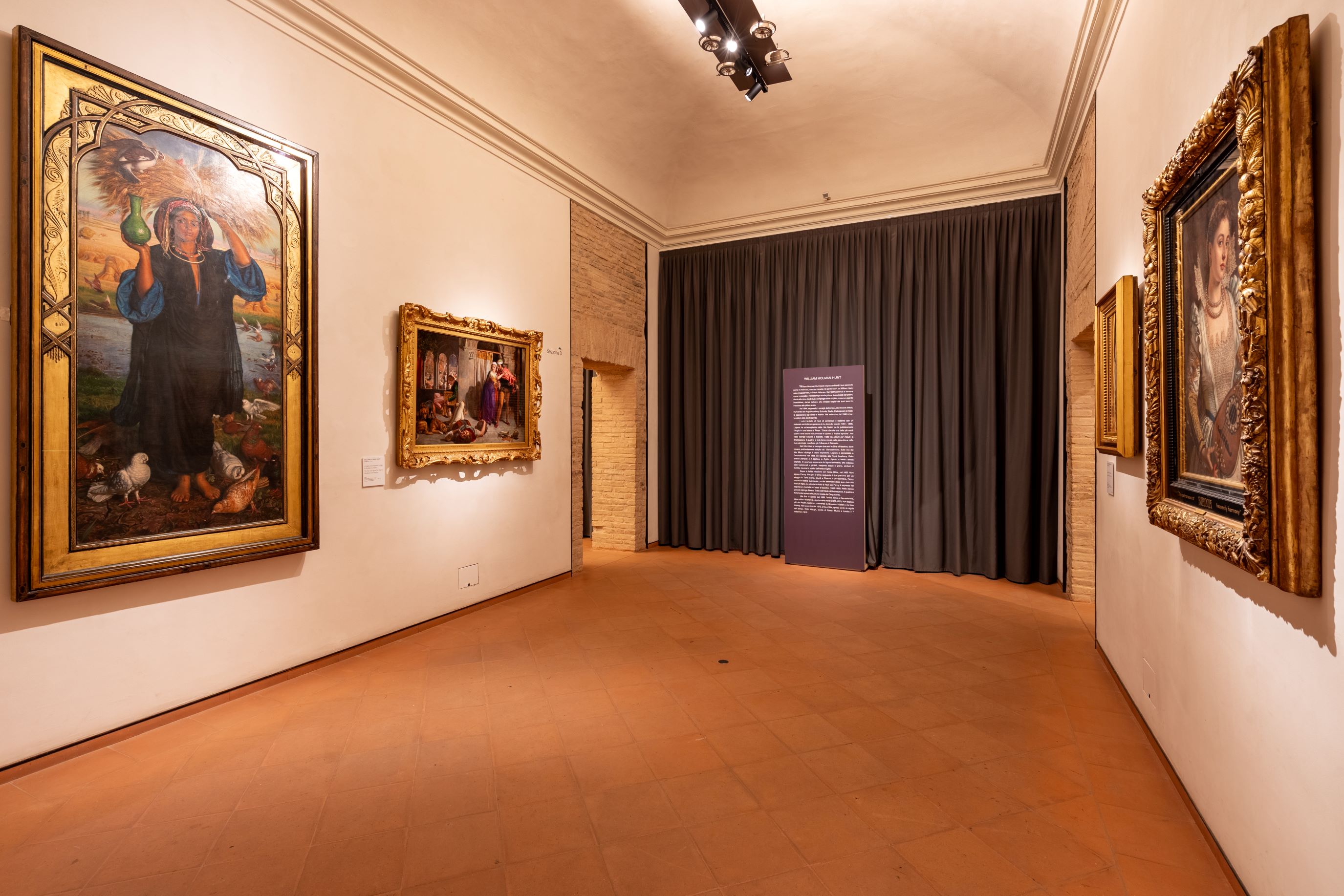
From left to right: (a) Millais's Design for an Album Cover. (b) Paintings by Ford Madox Brown. (c) Paintings by William Holman Hunt.
If Italian visitors were expecting to see major early landmark paintings by members of the Pre-Raphaelite Brotherhood, such as were shown at Pre-Raphaelites: Victorian Avant-Garde at Tate Britain in 2013, they would have been somewhat disappointed. For any exhibition curators are limited in what they are able to show by what works institutions and private collectors are willing and able to lend and whether works are stable enough to travel. For anyone with a serious interest in and knowledge of this period, however, this show proves to be even more interesting. I have been attending Pre-Raphaelite exhibitions for nearly fifty years and there are many works here I had never seen before except as illustrations in books. These include items such as D. G. Rossetti's "Hist" Said Kate the Queen of 1848-51 from Eton College, J. E. Millais's Design for an Album Cover (see above left) of 1842 from Vassar College, and the watercolour version of Lorenzo and Isabella from the Guildhall Art Gallery in London. Ford Madox Brown is well represented by the works in his room, including The First Translation of the Bible into English: Wycliffe Reading his Translation of the New Testament to John of Gaunt of 1847-48 from Bradford, and Jacob and Joseph's Coat borrowed from Museo de Arte de Ponce (see the central photograph above). Holman Hunt is represented by such important works as The Eve of St. Agnes, the small version of Claudio and Isabella from the Makins collection, and the small version of Isabella and the Pot of Basil from the Fine Arts Museums of San Francisco. Associates of the Pre-Raphaelite Brotherhood such as Walter Deverell, J. N. Paton, F. W. Burton, Arthur Hughes, and Charles Collins are all well represented, including Deverell's Twelfth Night of 1850, certainly one of the masterpieces of the first phase of Pre-Raphaelitism, and featuring Deverell himself, D. G. Rossetti, and Elizabeth Siddal as models.

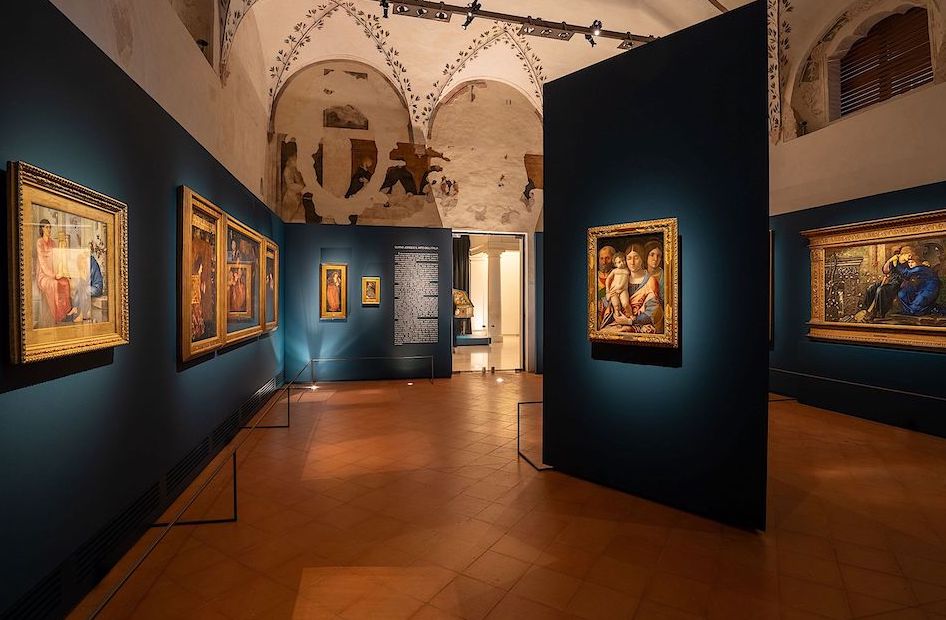
Left: Edward Burne-Jones: the Graham piano, and stained glass by William Morris, Henry Holiday, and Edward Burne-Jones. Right: The Burne-Jones room.
Burne-Jones has one large room devoted to his work making him perhaps the "star of the show." Major works from all periods of his career, thirty-two in total, have been included along with works by the Old Masters who influenced him. He had first traveled to Italy in 1859, accompanied by his friends Val Prinsep and Charlie Faulkner, and then returned several times subsequently. On his return from Italy in 1871 he wrote: "So that now I care most for Michel Angelo, Luca Signorelli, Mantegna, Giotto, Orcagna, Botticelli, Andrea del Sarto, Paolo Uccello, and Piero della Francesca." Works by some of these Old Masters are included in this room as comparisons, as well as Giovanni Bellini's Santa Giustina [Saint Justina of Padua] , a work that would have greatly appealed to Burne-Jones. It is a pity the curators were unable to borrow Burne-Jones's The Hours to hang near Filippino Lippi's Five Allegorical Female Figures, as this would have made a very interesting juxtaposition. The show does include such favourites of mine as The Lament of 1866, The Mill of 1870, the three paintings of the "small" Briar Rose Series of 1871-73, and the oil version of Love Among the Ruins from 1894 but which was based on his earlier watercolour version of 1873. I was particularly delighted to see Alphonse Legros's Portrait of Edward Burne-Jones of 1868-69 that I had first seen in Aberdeen many years ago included in this section. It is superb and resembles a High Renaissance portrait by Pontormo or Bronzino.
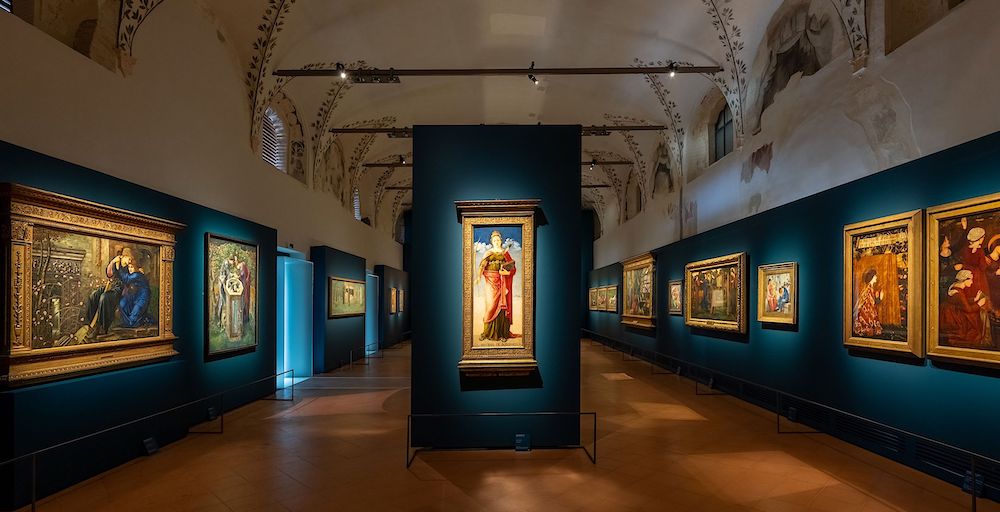
Another view of the Burne-Jones room.
The section on the later works of Rossetti fails to match the splendour of the Burne-Jones section, likely because the recent Rossetti exhibition at Tate Britain and at Delaware limited the works available to be borrowed. While not many of the Rossetti's "stunners" have been included, curators did borrow The Roman Widow from Ponce, which was the work chosen for the cover of the catalogue and used in posters to advertise the show. It was a delight to see works not usually seen such as his oil Portrait of Ruth Herbert from the Bristol Museum & Art Gallery and the chalk Portrait of Jane Morris from the National Gallery of Modern and Contemporary Art in Rome. In their Rossetti section the exhibition also made tantalizing use of Old Master paintings by artists such as Bernardo Luini, Filippo Lippi, and Jacoba Palma Vecchio. Rossetti had established the fashion for sensual female half-length portraits influenced by Venetian painting with his Bocca Baciata of 1859, a copy of which by Charles Fairfax Murray is in the show. It was easy to see how he had drawn on examples like the Portrait of a Courtesan by Palma Vecchio for inspiration.
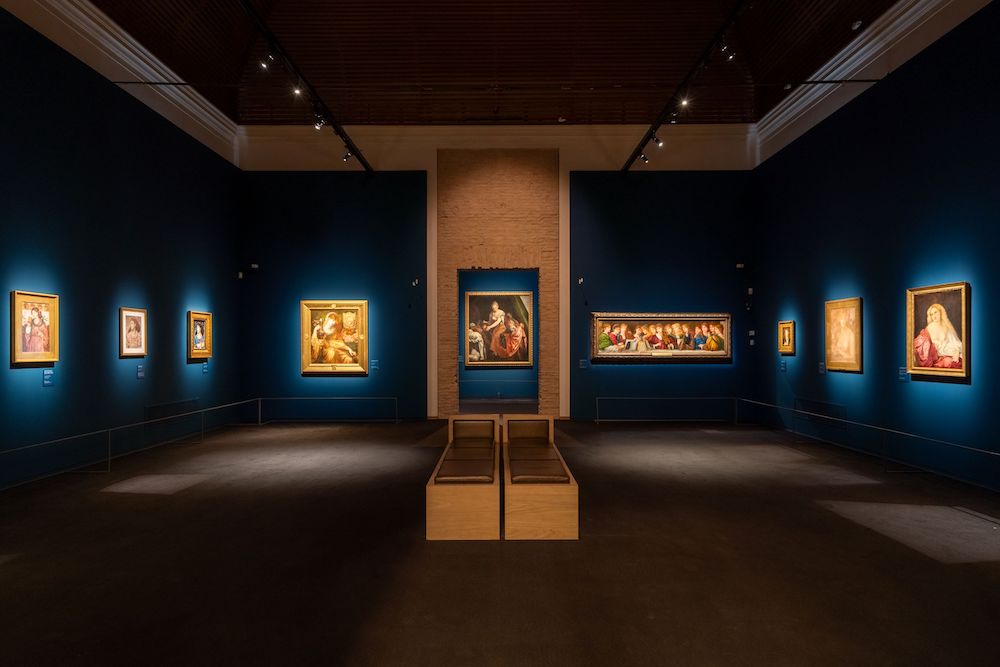

Left: The Rossetti room. Right: Rossetti's Portrait of Ruth Herbert.
Frederic Leighton is another artist who figures prominently in the show with twenty-four works, including two bronze statuettes. I was impressed that the curators selected two of his La Nanna studies of the Italian model Anna Risi, including La Pavonia, to show alongside a painting by the German Anselm Feuerbach in which she was the model for the Madonna. Risi had been Feuerbach's mistress during his time in Rome. The influence of Venetian paining on his oeuvre is well demonstrated by the inclusion of his A Noble Lady of Venice of 1866. Showing a painting by Guido Reni, known for his swirling draperies, alongside Leighton's Greek Girls Picking up Pebbles by the Sea makes a highly appropriate comparison. Leighton's The Music Lesson is a superb example of Leighton's involvement with the Aesthetic Movement with the black and white pillars in the background reminiscent of those found in the gothic Duomo in Sienna.

The Leighton room.
Unfortunately G.F. Watts, an artist much influenced by the work of Titian, does not get a particularly satisfactory work by this Italian master as a comparison to his very Titian-like paintings Ariadne in Naxos and Europa. This is one of the few times I thought the Italian curators could surely have come up with something more appropriate. Fortunately William Etty's copy of Titian's The Pastoral Concert partially makes up for this omission. The show also includes my favourite sculpture by Watts, a bronze cast of Clytie of 1867-69. It was good to see three major works by Edward Poynter in the show. Poynter is an important but much neglected Victorian artist who surely deserves a full-fledged retrospective of his works. Poynter greatly admired Michelangelo, which is very obvious in the works shown. Val Prinsep, who can be a somewhat uneven artist, is represented by one of his finest works Leonora di Mantau of 1873. It was also a pleasure to see Thomas Armstrong represented by a substantial work, his Woman with Lilies of 1876.

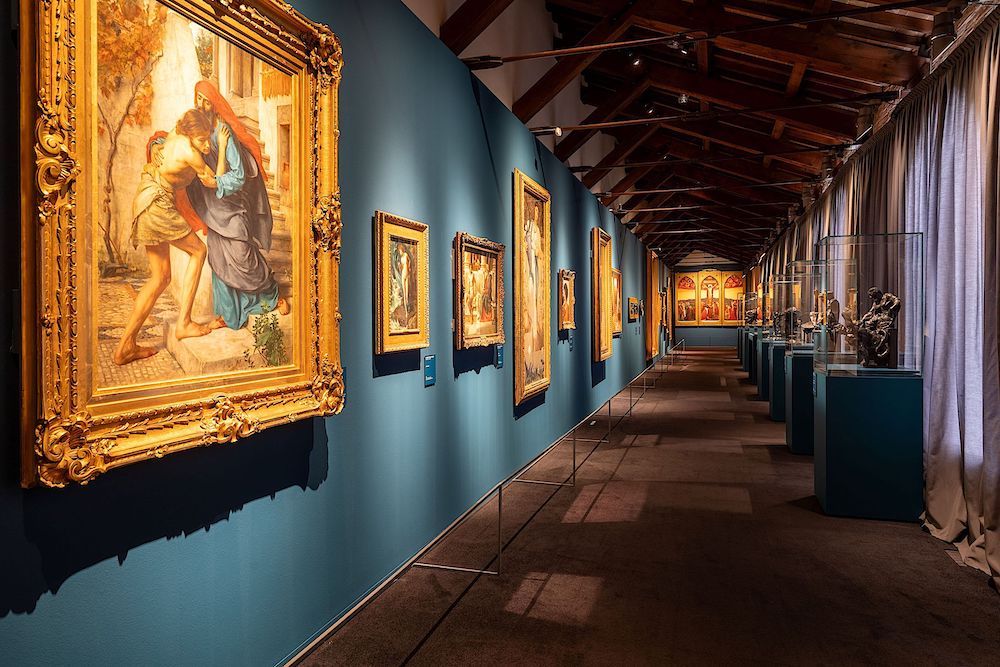
Work by (left): Watts, and (right) E. J. Poynter (with The Prodigal's Return on the far left and New Sculpture in the display cases on the right).
Sculpture in the Exhibition
Significant prominence has been given to the New Sculpture movement with works by Leighton, Alfred Stevens, Alfred Gilbert, F. W. Pomeroy, Edward Onslow Ford, William Goscombe John, and Harry Bates. In view of the title of the exhibition it is somewhat surprising that no works have been included by "Pre-Raphaelite sculptors" per se, such as Thomas Woolner, Alexander Munro, John Hancock, or John Lucas Tupper. The reason for this was obviously because these artists were not nearly so influenced by Renaissance sculpture as those involved in the New Sculpture movement. Alfred Stevens, the godfather of the New Sculpture Movement, Frederic Leighton who initiated the movement with his Athlete Wrestling With a Python, and Alfred Gilbert, perhaps the most talented sculptor of this younger generation, all spent significant time living in Italy where they studied Renaissance sculpture and statuettes. A section is also included on art medals influenced by the Renaissance medals of Pisanello. Alphonse Legros was the principal instigator for the late-nineteenth-century revival of the medal in Britain with his first medals belonging to 1881. Medals by Poynter and Maria Cassavetti Zambaco are also shown.
Followers of Burne-Jones, and Later Pre-Raphaelites
In the section devoted to the important followers of Edward Burne-Jones including T. M. Rooke as well as those already enumerated above, Simeon Solomon deserves special mention: looking at his masterpieces Love in Autumn of 1866 and Sleepers and One that Waketh of 1871 it is hard to believe he was already undertaking such symbolist themes so early on in his career. Women artists are also particularly well represented in this section. Wonderful examples of their work have been incorporated, including pictures I had not seen before like Marie Stillman's Hera and Evelyn De Morgan's Medea. De Morgan's masterpiece Flora, clearly influenced by Botticelli, is another highlight.


Left: Works by Evelyn De Morgan. Right: Works by J. R. Stanhope, J. M. Cameron and M. Stillman.
Later successors of the Pre-Raphaelites of the third generation are well represented in the show, too. These include John William Waterhouse, Charles Ricketts and Charles Shannon, Frank Dicksee, John Byam Shaw, Eleanor Fortescue-Brickdale, Joseph Southall, E. R. Frampton, Thomas Cooper Gotch, Phoebe Anna Traquair, and Marianne Stokes.
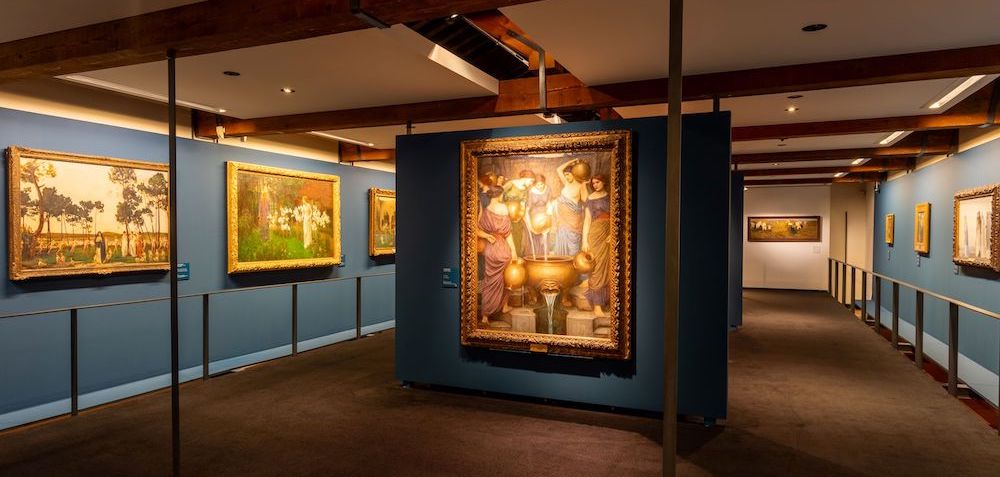
The Last Generation.
A final section of the show is devoted to late nineteenth and early twentieth century Italian artists who had, in turn, been influenced by Pre-Raphaelitism, including such names as Allesandro Morani, Giuseppe Cellini, Adolfo de Carolis, Giulio Aristide Sartorio and Filadelfo Simi. Giovanni Costa was the only Italian painter of this period I was personally familiar with. In this exhibition, however, the painters chosen are largely figurative painters rather than the Italian followers of Giovanni Costa's Etruscan School, although one Etruscan landscape by Costa is shown. Sartorio's triptych of The Wise and Foolish Virgins of 1890-91 and De Carolis's Praised be you for the beautiful light you give to the earth of 1900 are particularly striking examples of Pre-Raphaelite influences.
The Catalogue

A magnificently illustrated catalogue of nearly 600 pages accompanies the exhibition. This is a really hefty tome and I would advise any interested international visitors to have it shipped to them rather than trying to carry it home because of its weight. The catalogue is published in Milan by Dario Cimorelli Editore. However, it is only available in Italian, which is unfortunate for those unable to read this language because it has truly superb essays by the curators for the show, whether Italian or English and American. Liz Prettejohn writes on "British Art and the Italian Renaissance," and "Victorian High Renaissance", Peter Trippi on "The Pre-Raphaelite Revolt," Tim Barringer on "The Nature of Gothic: Victorian Culture and the Medieval Era," Susan Owens on "Conversations with the Past," Stephen Calloway on "Quaint Charms of Invention: Pre-Raphaelites on Paper," and Charlotte Gere on "A Modern Renaissance: Forging a New Language for Reformed Design and the Applied Arts." Essays by Italian curator Francesco Parisi include "The Romance of Italy. The Pre-Raphaelites in Venice, Florence and Rome" and "A Pre-Raphaelite Brotherhood in Italy. 'In Arte Libertas,' 1886-1902." Cristina Acidini writes on "Love and Exile. Florence in the Pre-Raphaelite Mirror between Dante and Botticelli." I was particularly pleased that catalogue entries were included and not just essays, which has happened with many recent catalogues. The catalogue entries for individual works are also well worth reading. It is to be hoped that some way can now be found to subsequently publish at least the essays in English because they add a much greater understanding of what the exhibition has tried to accomplish. Some of the information provided is truly groundbreaking and not merely a rehash of what I have read many times previously. The essays provide fresh insights into all aspects of the Pre-Raphaelite movement in all its wider contexts.
In summary this is an extraordinary show unmatched in its scope and depth, and would appeal to all visitors, whether Italians seeing Pre-Raphaelite art for the first time, or well-informed scholars of this movement who would have the opportunity to see works not generally included in previous exhibitions. I have not seen an exhibition of this size and scope since John Christian's landmark exhibition The Last Romantics held at the Barbican Art Gallery in 1989. I would definitely suggest a visit before the show closes if it is at all possible. If not, the catalogue is well worth buying to get a feeling of what was exhibited.
Created 27 May 2024